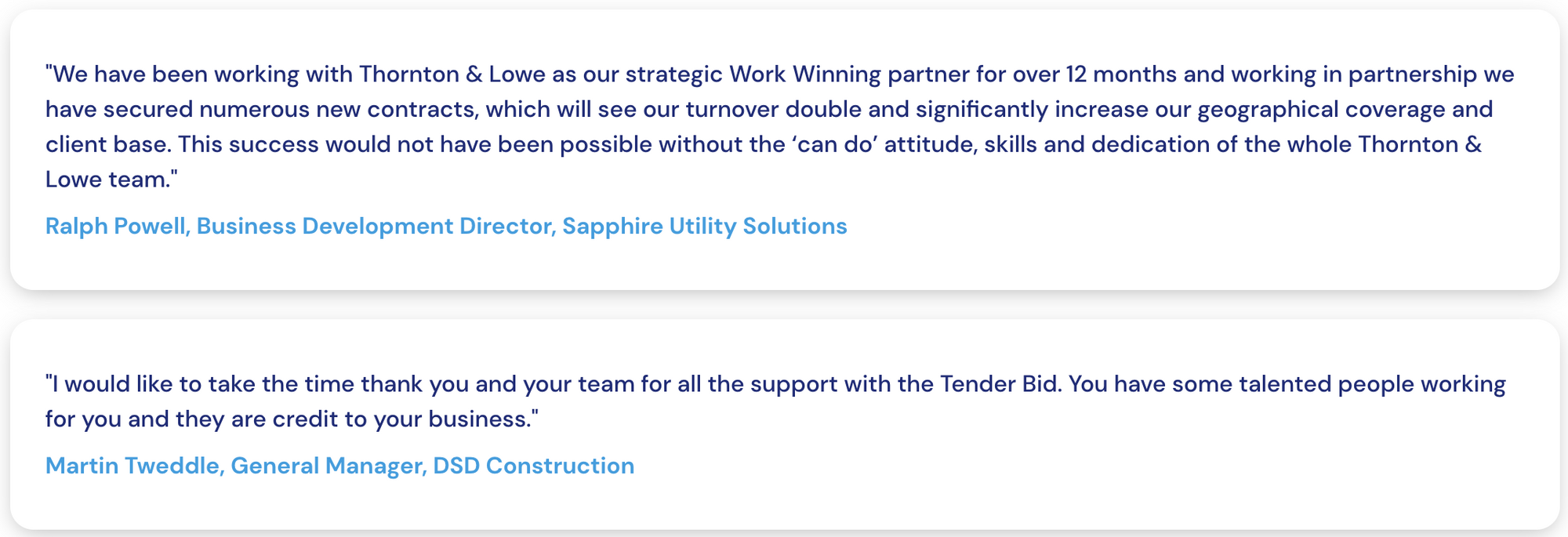Understanding Pricing Schedules
Pricing schedules are tools used in procurement to outline the costs of goods or services. They help buyers fairly evaluate your price on a like for like basis.
A typical pricing schedule includes:
- Item descriptions
- Quantities
- Unit prices
- Total costs
You'll see pricing schedules in pretty much every government tender you bid for.
Pricing schedules can be simple or complex. Some might have just a few items, while others could list hundreds of products, options and take some real time to get to grips with. Within public sector tenders the benefit is that will come with instructions and you have the chance to ask clarification questions to ensure you have a full understanding of the pricing requirements.
Remember, prices in a schedule might change based on factors like:
- Market conditions
- Raw material costs
- Labour rates
Check the terms within the tender pack to make sure you understand whether prices will be fixed or linked in inflation, for example. If this is not clear - ask the question.

Components of a Pricing Schedule
A pricing schedule has several key parts that work together to set clear expectations for buyers and sellers. From a bidders perspective they can become valuable terms in terms of future reporting once you have won the contract and also to support future bids.
Base Price
The base price is the starting point for your pricing schedule. It's the standard cost for your product or service before any discounts or adjustments. When setting your base price:
- Look at your costs and desired profit margin
- Check what competitors charge
- Think about what similar customers are willing or able to pay
Your base price should cover your expenses and leave room for profit. It's smart to review and update it regularly as costs change. You want to win the tender but it needs to be sustainable and worth the effort of bidding!
Volume Discounts
Volume discounts reward customers who buy more. They can help you sell larger quantities and keep loyal customers. For example:
- Decide on discount tiers (e.g. 5% off for 100+ units, 10% off for 500+)
- Make sure discounts don't cut into your profits too much
- Keep the tiers simple and easy to understand
You might use a table like this:
| Quantity | Discount |
|---|---|
| 1-99 | 0% |
| 100-499 | 5% |
| 500+ | 10% |
Be clear about any minimum purchase amounts needed for discounts. While you may not get the opportunity to share this in a formal public sector tender, you will still be able to use the approach as a way to offer value for money.
Time-Based Adjustments
Time-based adjustments change prices based on when something is bought or used. They can help manage demand and boost sales during slow periods. Examples include:
- Seasonal pricing (e.g. higher rates during peak tourist season)
- Off-peak discounts (e.g. cheaper gym memberships for daytime use)
- Early bird specials (e.g. lower prices for booking early)
When using time-based adjustments:
- Make the rules clear to avoid confusion
- Don't change prices too often, as it might annoy customers
- Use them to smooth out demand, not just to charge more
Within a formal tender environment the key is understanding what discounts you would be able to offer due to the specific requirements of the buyer and applying these within the schedule. For example, if they require a simple 'price per visit' throughout the year, if you know that part of the year there will be less work to do then you can of course reflect this in your overall rate and contract price.
Payment Terms
Payment terms spell out when and how customers should pay. They affect cash flow and can be used to encourage prompt payment. Common payment terms include:
- Net 30 (full payment due in 30 days). The Government has a prompt payment policy to confirm this.
- 2/10 Net 30 (2% discount if paid within 10 days, otherwise full amount in 30 days)
Within a formal tender or ITT, you are often encouraged to provide discounts for early payments so it is important to consider your cash flow needs, as well as promoting the discount.
Prefer to discuss?
Click here
Thornton & Lowe: Navigating Pricing Schedules in Tender Responses
While Thornton & Lowe does not provide pricing for bids, we support you in every other aspect of responding to tenders, ensuring your submission is as competitive as possible.
- Tender selection support – We help you identify and select the right tenders, ensuring they align with your business goals and capabilities.
- Bid writing expertise – Our team will guide you through the process of writing compelling, compliant tender responses, making sure your pricing aligns with the overall submission.
- Training and guidance – We offer tailored training on responding to tenders, helping you prepare for future bids.
- Maximising your tender responses – Technical and quality responses to help you strengthen your submission!
At Thornton & Lowe, we focus on supporting you through every stage of the tender process - from selecting the right tenders to providing expert bid writing and training. Get in touch today to learn how we can help you win more contracts.

Types of Pricing Schedules
Pricing schedules come in different forms to suit various business needs and market conditions. Each type has unique features that can impact your pricing strategy and customer relationships.
Fixed Pricing
Fixed pricing keeps costs steady over time. You set a single price for your product or service that doesn't change. This method is simple to use and easy for customers to understand.
It works well for products with stable costs and demand. Fixed pricing can help you plan your income more easily. It also saves time since you don't need to adjust prices often. But it may not work well if your costs change a lot or if demand varies greatly.
Dynamic Pricing
Dynamic pricing changes based on market factors. Your prices might go up or down depending on labour rates, inflation, demand, time of day, or other variables.
Less common in tenders but you do see if occasionally. A well known example is Airlines. Ticket prices can change quickly based on how many seats are left or how close it is to the flight date, or school holidays....
This method can help you make more money when demand is high. It can also help you sell more when demand is low by lowering prices. But it can be complex to manage and might confuse some customers. To confirm, this is rare in public sector tendering.
Tiered Pricing
Tiered pricing offers different price levels based on usage or features. You create several packages or plans, each with its own price point.
Software companies often use this method. They might offer a basic plan, a mid-range plan, and a premium plan. Each tier includes more features or allows more users.
This approach lets customers choose what fits their needs and budget. It can also encourage customers to upgrade to higher tiers. But you need to make sure the value of each tier is clear to avoid confusion.
Transparent Pricing for Public Sector Bids
Most public sector tenders and frameworks provide a structured pricing schedule for you to complete. Transparency is often high on the agenda, which dictates the requirements. For example, you may be asked to provide an annual cost alongside a full breakdown of your costs, including staffing, plant and equipment and your margin!

Creating a Pricing Schedule Template
A pricing schedule template or base for your pricing approach when bidding for contracts can help businesses ensure control and consistency and ensure they can learn from feedback.
Market Analysis
Start by researching your competitors' prices. Look at similar products or services in your industry. This gives you a baseline for setting your own rates.
Make a list of your top rivals. Note their prices for each offering. Compare their features to yours. Are there any unique selling points that justify higher prices? What is the quality / price split and how can you compete?
Consider factors like location, target market, and brand reputation. These can impact pricing strategies. A luxury brand might charge more than a budget-friendly option of course, but within a tendering environment it still needs to stack up based on the percentage weightings.
Don't just copy others. Use this info to position your prices strategically.
Tender Pipeline is our free tool, which you can use to find who is winning contracts in your sector, as well as setting up tender alerts for live opportunities.
Cost Analysis
Calculate all costs linked to your product or service. This includes direct costs like materials and labour. Don't forget indirect costs such as overheads and marketing.
Make a detailed list:
- Raw materials
- Production costs
- Shipping fees
- Staff wages, including contract management
- Rent and utilities
- Marketing expenses
- Cost implication of added value and social value offered in the bid
Add up these costs for each item you sell. This is your break-even point. You must price above this to make a profit.
Consider volume discounts from suppliers. Bulk ordering can lower your costs.
Profit Margin Calculations
Decide on your desired profit margin. This is the percentage of profit you want to make on each sale.
Use this formula: (Selling Price - Cost) / Selling Price = Profit Margin.
For example, if an item costs £10 to make and you sell it for £15: (£15 - £10) / £15 = 33% profit margin. Adjust your prices to hit your target margin. Balance this with market rates to stay competitive.
Consider different margins for various products. High-volume items might have lower margins than specialty goods. Test different price points. See how they affect sales and overall profits.
Within a public sector pricing schedule they may provide a 'basket of goods' for you to price with example volumes. You need to use your knowledge of the customers' requirements in order to get this right, giving you the chance to provide value for money and maximise the scores available.

Bid Writing Services & Pricing
At Thornton & Lowe, we have a range of bid management consultancy services aimed at helping SMEs bid and win public sector tenders. Our bid writing services include:
- Bid management
- Bid writing
- Bid reviews
- Bid administration and portal management
- Tender alerts
- Bid writing courses
Commercials and completing pricing schedules is not an area we directly support, other than for grounds maintenance tenders, due to our in-house capability. However, it is important we understand your pricing strategy and resulting delivery model, mobilisation and management team, for example.




